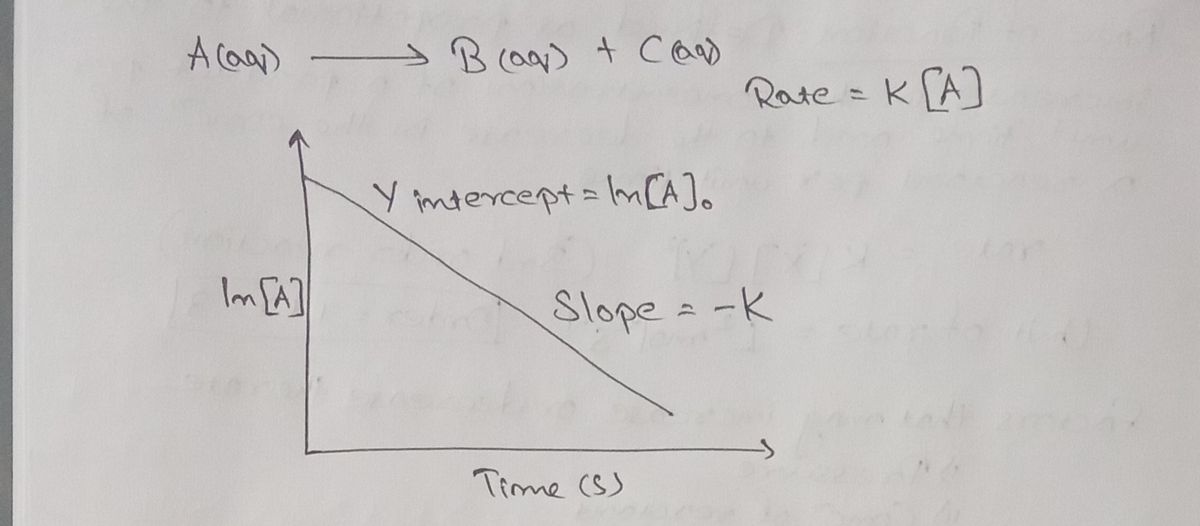Chemistry
10th Edition
ISBN:9781305957404
Author:Steven S. Zumdahl, Susan A. Zumdahl, Donald J. DeCoste
Publisher:Steven S. Zumdahl, Susan A. Zumdahl, Donald J. DeCoste
Chapter1: Chemical Foundations
Section: Chapter Questions
Problem 1RQ: Define and explain the differences between the following terms. a. law and theory b. theory and...
Related questions
Question
![A chemical reaction is represented as follows:
\[ A(aq) \rightarrow B(aq) + C(aq) \]
A plot of \(\ln[A]\) versus time gives a straight line with a negative slope. What is the order of the reaction?
**Explanation:**
In chemical kinetics, if a plot of the natural logarithm of the concentration of a reactant (\(\ln[A]\)) versus time yields a straight line with a negative slope, this indicates that the reaction is first-order with respect to the reactant \(A\). The linear relationship suggests that the rate of reaction depends exponentially on the concentration of \(A\).
**Key Concepts:**
- **First-Order Reaction:** The rate is directly proportional to the concentration of one reactant. For a first-order reaction, the integrated rate law is \(\ln[A] = -kt + \ln[A_0]\), where \(k\) is the rate constant and \([A_0]\) is the initial concentration.
- **Graphical Representation:** The straight line on the plot demonstrates a linear relationship as predicted by the first-order kinetics, with the slope being equal to \(-k\).
Understanding these concepts assists in predicting reaction behaviors and calculating reaction rates.](/v2/_next/image?url=https%3A%2F%2Fcontent.bartleby.com%2Fqna-images%2Fquestion%2Fbe983b18-ee33-44db-82aa-7c6bfcc1e549%2F67778b54-a751-4f15-93fb-f26da0a3f5b8%2Foxvnlo_processed.jpeg&w=3840&q=75)
Transcribed Image Text:A chemical reaction is represented as follows:
\[ A(aq) \rightarrow B(aq) + C(aq) \]
A plot of \(\ln[A]\) versus time gives a straight line with a negative slope. What is the order of the reaction?
**Explanation:**
In chemical kinetics, if a plot of the natural logarithm of the concentration of a reactant (\(\ln[A]\)) versus time yields a straight line with a negative slope, this indicates that the reaction is first-order with respect to the reactant \(A\). The linear relationship suggests that the rate of reaction depends exponentially on the concentration of \(A\).
**Key Concepts:**
- **First-Order Reaction:** The rate is directly proportional to the concentration of one reactant. For a first-order reaction, the integrated rate law is \(\ln[A] = -kt + \ln[A_0]\), where \(k\) is the rate constant and \([A_0]\) is the initial concentration.
- **Graphical Representation:** The straight line on the plot demonstrates a linear relationship as predicted by the first-order kinetics, with the slope being equal to \(-k\).
Understanding these concepts assists in predicting reaction behaviors and calculating reaction rates.
Expert Solution
Step 1
Hinhh
Step by step
Solved in 2 steps with 2 images

Knowledge Booster
Learn more about
Need a deep-dive on the concept behind this application? Look no further. Learn more about this topic, chemistry and related others by exploring similar questions and additional content below.Recommended textbooks for you

Chemistry
Chemistry
ISBN:
9781305957404
Author:
Steven S. Zumdahl, Susan A. Zumdahl, Donald J. DeCoste
Publisher:
Cengage Learning

Chemistry
Chemistry
ISBN:
9781259911156
Author:
Raymond Chang Dr., Jason Overby Professor
Publisher:
McGraw-Hill Education

Principles of Instrumental Analysis
Chemistry
ISBN:
9781305577213
Author:
Douglas A. Skoog, F. James Holler, Stanley R. Crouch
Publisher:
Cengage Learning

Chemistry
Chemistry
ISBN:
9781305957404
Author:
Steven S. Zumdahl, Susan A. Zumdahl, Donald J. DeCoste
Publisher:
Cengage Learning

Chemistry
Chemistry
ISBN:
9781259911156
Author:
Raymond Chang Dr., Jason Overby Professor
Publisher:
McGraw-Hill Education

Principles of Instrumental Analysis
Chemistry
ISBN:
9781305577213
Author:
Douglas A. Skoog, F. James Holler, Stanley R. Crouch
Publisher:
Cengage Learning

Organic Chemistry
Chemistry
ISBN:
9780078021558
Author:
Janice Gorzynski Smith Dr.
Publisher:
McGraw-Hill Education

Chemistry: Principles and Reactions
Chemistry
ISBN:
9781305079373
Author:
William L. Masterton, Cecile N. Hurley
Publisher:
Cengage Learning

Elementary Principles of Chemical Processes, Bind…
Chemistry
ISBN:
9781118431221
Author:
Richard M. Felder, Ronald W. Rousseau, Lisa G. Bullard
Publisher:
WILEY